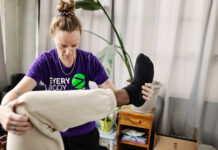Runners often suffer knee pain, so much so that they have their own condition known as Runner’s Knee. The technical term is patellofemoral pain syndrome (PFPS) and symptoms include pain around the patella (kneecap), inflammation surrounding the knee after exercising and tight quadriceps. This syndrome is common among highly active individuals, who do not have proper alignment and tracking of the patella.
The stress from exercise exerts pressure on the patella, causing it to rub against the femur underneath. This often leads to inflammation of the synovial membrane/joint lining. Continued misalignment of the knee cap can lead to deterioration of cartilage surrounding the knee, which reduces shock absorption and increases the chances of the knee dislocating.
Ice, rest and wearing a brace are good temporary solutions, but do not cure the underlying issue, often caused by weak glutes, quads and hamstrings. The best method to counteract PFPS is to strengthen those muscles via corrective exercises.
Try These Exercises

Band Walks
Wrap a therapeutic band around your ankles and plant your feetshoulder-width apart.
- Bend knees 45 degrees while maintaining a straight back; contract your glutes and take a short side step in one direction, with the other leg following.
- After about 15-20 steps in one direction, rest for 20 seconds, then reverse and repeat.
- Aim for three rounds/day, four times/week to strengthen the glutes.

Terminal Knee Extensions
- Loop a resistance band around a sturdy table and slide the other end of the loop up your right leg, slightly above the knee
- Facing the table, take a few steps back until there is tension on the resistance band.
- Plant your left foot on the ground; lift your right knee until only your toes are touching the ground.
- Strongly contract your right quadriceps and push down the right heel; hold this contraction for two seconds then slowly return to starting position.
- Do 15 repetitions then switch legs; aim for three sets for each leg.
- Try these exercises before a workout to activate those dormant muscles. This should minimize knee pain during and after your workout.
















